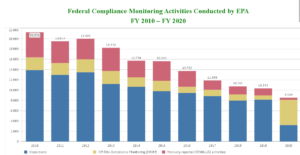On January 13, 2021, one week prior to the end of the Trump administration, the Environmental Protection Agency released its annual enforcement report for the prior year – “EPA Enforcement Annual Results FY 2020.” https://epa.maps.arcgis.com/apps/Cascade/index.html?appid=9dfe57199392498f872bac6bf2e4867c In keeping with the rhetorical style of the former president, EPA claimed that it had achieved “tremendous results for the public and the environment.” When one looks below the surface, however, a different picture appears.
EPA’s FY 2020 report identifies the following as the “highlights” of its “National Compliance Initiatives” (NCI) efforts to address “the most serious environmental violations,” violations on which EPA “focuses” its enforcement and compliance resources:
• Reducing the National Pollutant Discharge Elimination System (NPDES) Significant Non-Compliance one-quarter rate from a FY 2018 baseline of 20.3% to 16.4%, continuing progress toward achieving the goal of cutting the Significant Non-Compliance rate in half by FY 2022.
• Resolving 31 cases as part of the Stopping Aftermarket Defeat Device NCI.
• Reducing almost 27 million pounds of volatile organic compounds and over 2.8 million pounds of hazardous air pollutants under the Creating Cleaner Air for Communities NCI.
• Issuing a Clean Water Act compliance advisory on reducing significant non-compliance with NPDES permits and an enforcement alert on compliance with the Resource Conservation and Recovery Act air emissions requirements to assist the regulated community in understanding their obligations.
Let’s look at these four highlights, one at a time.
1. Reducing NPDES (Wastewater/Stormwater Discharge Permit) Significant Non-Compliance
Despite being the very first bullet point in the list of enforcement highlights, the report itself does not provide much information about the claimed accomplishment and only offers the stated percentage reduction (20.3% to 16.4%, with 10% “significant non-compliance” being the stated target). At first, this might seem impressive, but why is FY 2018 used as the baseline? What would the picture look like if a longer history were reviewed? Why is this amount (16.4%) of “significant” non-compliance happening? Why is the target 10%, and not 0%?
2. Resolving 31 cases as part of the “Stopping Aftermarket Defeat Device” Initiative
Thirty-one cases seems like a lot. But in many instances, the cases commenced before 2020 – and even before 2017, when the Trump administration assumed control. And although the number of “defeat device” cases has fluctuated over the years, 31 cases resolved in 2020 represents a reduction from 46 cases resolved in 2019. The real question is: how much non-compliance is ongoing and yet to be identified and/or sanctioned? The report does not address this.
Notably, the Trump EPA claimed that behind this enforcement initiative lies its understanding of its “critical role” in reducing air pollution from vehicles. “By making aftermarket defeat devices a national priority, EPA is addressing a significant contributor to air pollution. … EPA, through its direct implementation authority, can play a critical role in addressing these important pollutant sources.” Yet, during 2020, the Trump EPA sought to roll back regulations requiring more fuel-efficient vehicles in the coming years – reducing the required fleet average from 55 mpg by 2025 to about 40 mpg by 2026 – despite automakers agreeing that a higher mpg target was achievable. In fact, four of them took legal action in opposition to the announced rollback. The adverse impact on air quality from this deregulatory action dwarfs the positive impact of the defeat device enforcement initiative, which is largely aimed at small shops that customize engines.
3. Reducing almost 27 million pounds of volatile organic compounds (VOCs) and over 2.8 million pounds of hazardous air pollutants under the “Creating Cleaner Air for Communities” Initiative
As described by EPA, the Creating Cleaner Air for Communities NCI is a monitoring/inspection-based program. Monitoring and inspections lead to observed violations, which lead to enforcement actions, which result in emissions reductions. This is not a new approach; it is, actually, air pollution law enforcement 101. The Trump EPA’s FY 2020 report claims what appear to be large reductions (27 million lbs. of VOCs, and 2.8 million lbs. of hazardous air pollutants). But the report provides no baseline against which to measure the claimed achievements (is a 27 million pound reduction in VOCs a 0.001% reduction in overall national VOC emissions, a .0001% reduction, or even less?), and no context (e.g., are these annual reductions, or multi-year reductions?).
As is so often the case, answers lie in the details. In a table accessed through a link at the end of the report, one can see that EPA’s FY 2020 compliance inspection/monitoring activities (total, including on-site and off-site) were down from FY 2019 levels (and FY 2019 levels were down from FY 2018 levels; and FY 2018 levels were down from FY 2017 levels; and FY 2017 levels were down from FY 2016 levels).
4. Issuing a Clean Water Act compliance advisory and a Resource Conservation and Recovery Act enforcement alert to assist the regulated community in understanding their obligations
If one of the four claimed enforcement highlights of the year is the issuance of a compliance advisory and an enforcement alert, that is perhaps the most telling indication that enforcement by EPA under the Trump administration was not much of a priority.
Readers should not look to the narrative of the FY 2020 report for meaningful information about EPA’s enforcement performance over the past four years. The only useful, albeit summary, information in the report is found in the graphs and tables for which links are provided at the end of the report. This one presents a clear picture of the decline in enforcement activity:
Enforcement of compliance with federal environmental laws will be a higher priority under the Biden administration than it was for the past four years. However, with so little money in the federal budget, and with so much emphasis expected to be placed on the need for new initiatives to address climate change, only time will tell how much the desire to enforce existing law will translate into actual cases and sanctions.

